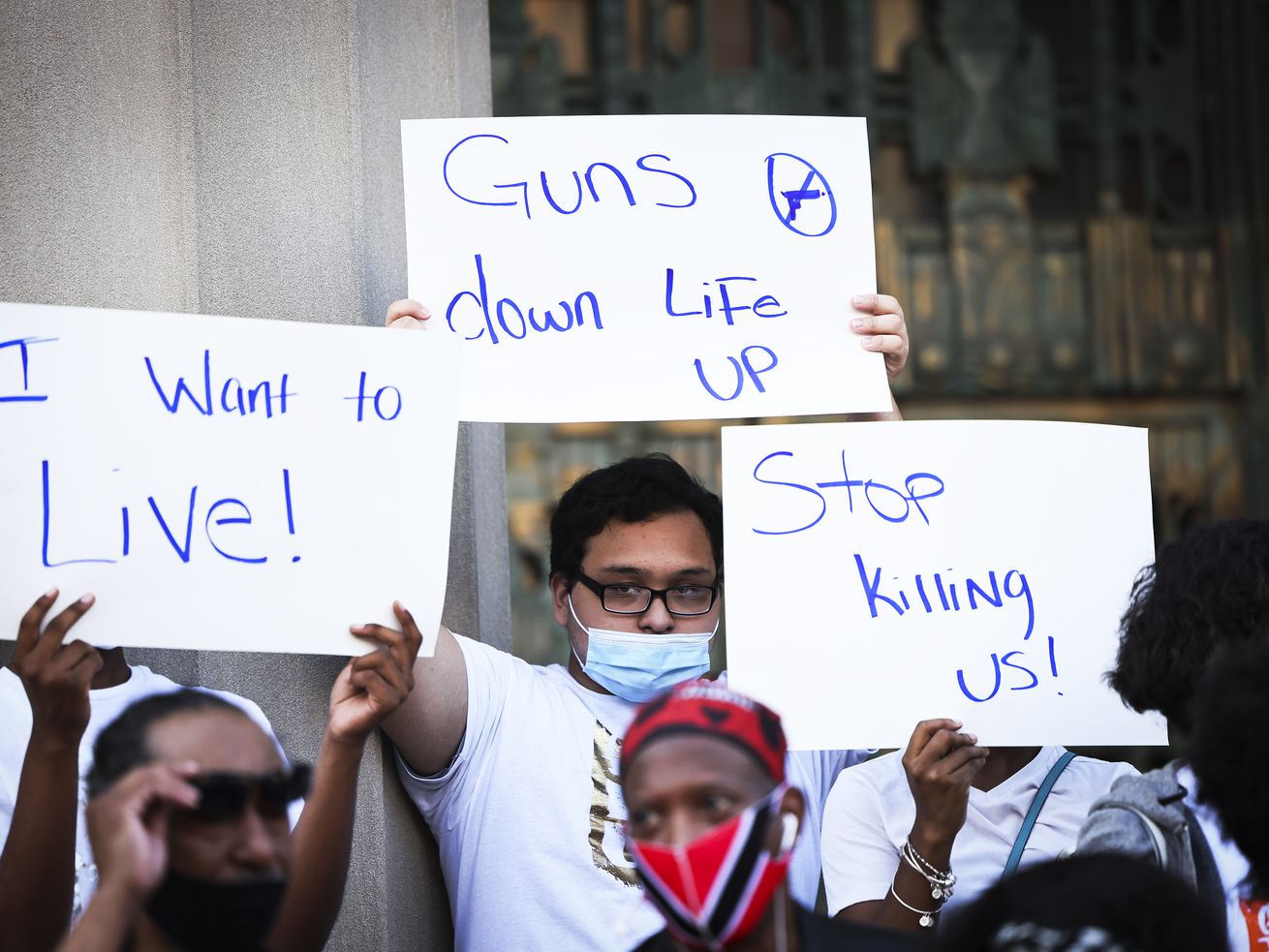In the quest for alternatives to police, interrupters simply aren’t a proven idea.
As progressives search for alternatives to traditional policing in the wake of the protests over George Floyd’s murder, one solution has gained prominence: violence interrupters.
For this approach, Groups like Cure Violence and Advance Peace recruit members of local communities, particularly people who have a history with gangs or violence, to act as mediators who can deescalate interpersonal conflicts before they turn violent.
In the short term, the goal is to stop shootings and murders. In the long term, it’s to foster stronger norms of peace within communities — an idea that, if it succeeds, could lead to a drop in violent crime broadly, without the need for armed officers capable of their own violence.
Interrupters were the subject of a splashy documentary in 2011. Since last year, they’ve gained more prominence as a solution, touted by progressives and cited by news outlets, including Vox, as a path forward in a world with fewer or no police officers. More recently, the concept has even gained federal support — with President Joe Biden’s administration aiming to direct new funds and other resources to interrupters, describing the approach as an “evidence-based model.”
/cdn.vox-cdn.com/uploads/chorus_asset/file/22823252/The_Interrupters_FilmPoster.jpeg) Wikipedia
WikipediaOne hope with interrupters is they might have a short-term effect on crime and violence — unlike other proposed alternatives to police, which tend to address root causes to disorder that can take years or generations to mend. For policymakers looking to address crime and violence now, that’s promising.
But studies on interrupters have been largely disappointing. Reviews of the evidence have found that the approach often produces no significant effect on shootings and murders, and some programs were even associated with more violence. While some studies have found positive effects, they are few and far between and suffer from methodological flaws. Taken together, the research is decidedly mixed — and offers little proof that the programs live up to their promise.
The research on interrupters “is mixed, incomplete, and very difficult to do,” Jeffrey Butts, a researcher at John Jay College of Criminal Justice who has studied violence interrupters, told me.
There’s nothing wrong with trying new ideas, and spending more time and money on the concept of interrupters could eventually bear fruit. But the focus on interrupters could lead policymakers astray as they deal with a new sense of urgency to do something about crime and violence in the US.
Over the past year and a half, America has seen a spike in shootings and murders. Murders likely rose by about 25 percent in 2020 and, though data remains limited to large cities, by 11 percent so far in 2021, based on crime analyst Jeff Asher’s tracker.
This is a crisis that policymakers are dealing with now, with political pressure mounting to do something quickly. So far, President Biden has embraced a “both and” approach that combines policing and alternatives like interrupters. But most crime-fighting policy is made at the state and local levels. If progressives manage to persuade local and state lawmakers to embrace interrupters over more proven approaches, it would be a roll of the dice — embracing a strategy with scant evidence, with lives at stake.
The evidence for interrupters is weak
Violence interruption was conceived by Gary Slutkin, head of Cure Violence, in Chicago in the 1990s as a public health response to shootings. The idea is that violence spreads like a disease — as, say, retaliatory shootings beget more retaliatory shootings — but interrupters can cut that cycle of violence short. With each of these interactions, interrupters hope to instill norms in a community against continued violence, showing a better path forward.
The concept picked up mainstream traction over the past year, particularly as the “defund the police” movement took off and policymakers sought alternatives to traditional policing.
Cure Violence Global and UNICEF save hundreds of lives! Thank you to Violence Interrupters and Outreach Workers! To hear more about their work, check out the link in our bio. pic.twitter.com/vgeMwK6B5t
— CureViolence (@CureViolence) July 2, 2021
But the evidence for the approach is mixed.
A 2015 review of the research, published in the Annual Reviews of Public Health, analyzed the results of interrupter programs across several American cities. None of the five studies included produced fully positive results, such as reductions in gun violence or murders. One program in Pittsburgh fared so poorly that it was linked to “an increase in rates of monthly aggravated assaults and gun assaults” in some neighborhoods.
The most famous of these studies, from 2009, looked at Chicago’s interrupter program. Comparing the sites of interrupter programs to similar areas, the study found positive effects for shootings in four of seven evaluation sites. Supporters would hope to see interrupter sites consistently perform better than comparable areas without the intervention; instead, they performed barely better than a coin flip.
The researchers also conducted social network analyses in these areas to see if they could pick up deeper changes in homicides and violence. They again found the outcomes varied widely.
“The evidence is mixed,” Butts, who led the 2015 review and subsequent research on interrupters, said. “We need to do more studies.”
A 2020 review from John Jay College, which examined various alternatives to police, concluded the evidence base for interrupters was “promising but mixed.”
Some of the studies produced positive effects. The most promising — a program in Port of Spain, Trinidad and Tobago — “was associated with significant reductions in overall violent crime (–45%) and shooting injuries (–39%).” A survey in New York gauged propensity for interpersonal violence among men ages 18 to 30, finding it dropped across areas both with and without interrupter programs but that “the decrease was steeper in Cure Violence areas (33% vs. 12%).”
But a bulk of the studies reviewed were mixed or disappointing. An interrupter program in Richmond, California, “may have been associated with statistically significant reductions in firearm violence, but researchers noted small increases in other types of violence.” Another in Baltimore had results that “were inconsistent across several sites.”
The research also consists of largely correlational work, with no randomized controlled trials — the gold standard for evidence — on interrupters to date. So instead of randomly selecting some neighborhoods, exclusively deploying interrupters there, and seeing how those places compare to similar areas, the studies typically looked at correlations between places where interrupters were believed to be active and places where interrupters by and large weren’t.
Given that less rigorous studies tend to be more likely to produce positive results for a studied intervention in crime and justice, it’s all the more worrying the weak studies for interrupters have found mixed to negative effects.
“It’s concerning,” Anna Harvey, a public safety expert at New York University who worked on the John Jay report, told me. “It really is an example of weak evidence.”
Advocates of the approach emphasize the more positive findings in the studies, including reductions in shootings in specific areas or neighborhoods. But the same studies also often found negative or null findings.
For example, the evidence summary from the interrupter program Cure Violence cited the 2009 Chicago evaluation to claim a “41% to 73% reduction in shootings.” But the bulk of this reduction wasn’t statistically significant; it didn’t differ from results in control groups, which is why the researchers could only link the intervention to drops in shootings in four of seven study sites — again, barely better than a coin flip.
When they acknowledge the mixed findings in the research, advocates of interrupters point to a range of problems. At the top, interrupter programs face inconsistent funding and support, particularly as changes in leadership and politics prompt the people in charge to divert resources elsewhere. That makes it difficult to implement these programs in the way they’re supposed to be implemented — and could explain some of the poor findings in the research.
“Not having a result in every community on every measure, to me, is way too high a bar with half funding, irregular funding,” Slutkin told me. “It has to be done right all the time — and that requires a consistent amount of training and technical assistance on the spot.”
They also argue that the approach is particularly difficult to research. As John Jay’s report noted, interrupter programs involve working with “individuals who are disconnected from traditional institutions and systems of support and are already involved in illegal activities.” Many of these people are going to be hard to follow in a scientific way, if they agree to participate in a study at all. That might lead to an absence of evidence without necessarily meaning the approach is ineffective.
Still, this is the evidence we have to work with. And based on that, the interrupter approach is at best mixed.
The choice isn’t interrupters or the current policing model
For some activists, the goal of these programs isn’t just to complement the jobs of police, but to replace them partially or entirely, using both interrupters and other approaches. Advocates, like #8toAbolition (a reference to abolishing the police) and DefundPolice.org, have repeatedly cited interrupter programs as an alternative to the police. The media has played a role, too: One article in Rolling Stone presented interrupters as one idea for a “Cop-Free World.” Another in Vox posed the idea of interrupters to help “replace traditional police officers.”
When Minneapolis officials last year moved to disband the city’s police department and replace it with a new public safety agency, they looked to interrupters as one of several possible replacements for traditional policing.
In the context of the current murder increase, relying on interrupters as an alternative to police, and framing it as such, when it lacks evidence is risky. Policymakers saw that in Minneapolis, where interrupters were reportedly sidelined as demands for more police patrols rose along with violence. Some Minneapolis officials have since walked back their support for disbanding the police department.
/cdn.vox-cdn.com/uploads/chorus_asset/file/22823305/GettyImages_1228190509_copy.jpg) Kerem Yucel/AFP via Getty Images
Kerem Yucel/AFP via Getty ImagesThere’s no reason interrupters have to be replacements to the police. There’s even less evidence for that than interrupters in general: The studies on interrupters were all done in places where police still exist, so even the most positive empirical findings assume cops are still around.
Nor is the alternative to interrupters simply accepting the status quo with police. It’s still possible to pursue reforms that tackle abuses, and adopt new practices that follow a less punitive, draconian model to policing. Some changes could explicitly embrace a public health approach — for example, deploying special teams, instead of police alone, for 911 calls regarding mental health crises.
Interrupters and police can work side by side, addressing different needs in different spaces — and they do in some cities. “They have different roles,” Slutkin said, although he envisions a world where interrupters are central to crime-fighting policy.
Other research finds strong indications that police do have an effect on crime and violence. A recent study published by the National Bureau of Economic Research concluded that more police officers reduce homicides, particularly in Black communities. Reviews of the evidence, including randomized controlled trials, have found strong evidence that specific strategies, like hot spot policing and problem-oriented policing, reduce crime and disorder.
These approaches still represent a break from the policing status quo in many places. They aren’t necessarily punitive; some hot spot policing approaches, for example, require cops to stand in high-crime blocks and take limited, if any, action — instead acting as largely armed surveillance, deterring wrongdoers.
“It doesn’t mean police are a panacea for these things,” Morgan Williams, an economist at Barnard College who studies crime and the criminal justice system, previously told me. “But it does mean we should be very careful about throwing around interventions that we don’t necessarily know come with any important benefits or costs.”
Now, the quantity of the research is skewed toward the policing approaches — making it difficult to say if policing has better evidence than the alternatives or if it’s simply received more attention.
Policing also likely has more costs than interrupters. If a policing approach goes wrong, the unintended consequences can be catastrophic — unnecessary arrests, harassment of neighborhoods, racial discrimination, and police shootings or killings. The downside of an interrupter approach gone wrong is more an opportunity cost: The time and resources dedicated to the program could have gone to something else, but there aren’t big, negative outcomes.
In short: Policing can be effective and doesn’t have to be punitive, but it can lead to bad, unintended consequences. Meanwhile, it’s not clear if interrupters can be effective, even if they don’t appear to lead to negative outcomes.
Of course, interrupters aren’t the only alternative to police for reducing crime and violence. There’s stronger evidence for other approaches, including offering summer jobs programs, raising the age to drop out of school, greening vacant lots, installing more streetlights, providing more drug addiction treatment, having better gun control laws, and raising the alcohol tax.
But these other alternatives tend to work over the longer term, since it takes time to, say, revitalize a community by providing more jobs and safe spaces to address root causes of crime.
The evidence on policing suggests a far quicker effect — since officers can reduce crime in an area the minute they’re deployed there, just by deterring through surveillance.
Interrupters are in some ways supposed to provide the same short-term benefit by stopping conflicts from escalating as soon as they’re deployed. That’s one reason that they’ve gotten so much attention compared to the other alternatives: For policymakers and a public looking for quicker solutions to crime and murder, whether benefits come in the short or long term is a crucial distinction.
But given the disappointing evidence for interrupters, it’s still not clear they can provide the short-term benefits that policing does. And with murders going up, American policymakers need evidence-based solutions to prevent potentially thousands more unnecessary deaths, hopefully right now.
Author: German Lopez
Read More



